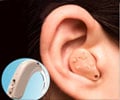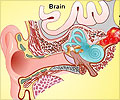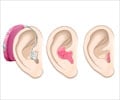A recent study by scientists at University of Wisconsin-Madison examines whether deaf children who've received two cochlear implants hear better
recent study by scientists at the University of Wisconsin-Madison examines whether deaf children who've received two cochlear implants hear better.
Led by Ruth Litovsky, an investigator in the UW-Madison Waisman Center, the team's research suggests that deaf children who have a cochlear implant in each ear more accurately locate sounds when they use both implants instead of one. Children with two implants also become more skilled at localizing sound over time.Information like this can be useful, says Litovsky, when doctors and parents are deciding whether a child should get one or two of the electronic devices, which allow deaf people to hear by bypassing the damaged inner ear, or cochlea, to stimulate the auditory nerve directly.
It's not a simple choice. A single implant and the required surgery can cost $50,000. The device also permanently damages the cochlea, which might prevent recipients from taking advantage of potentially superior treatments for deafness down the road.
Patients never received more than one implant until about ten years ago. Then, doctors began to fit people with two, hoping this would assist them in understanding speech, especially in 'cocktail party' environments with lots of competing sounds.
'But there are still many remaining questions about the actual extent of the benefits of having two cochlear implants,' Litovsky says. Only about three percent of the 100,000 people worldwide who currently wear implants have received two, she estimates.
Litovsky is an expert in binaural hearing, or hearing with two ears. 'We try to understand how having two ears is helpful,' she says. One main benefit: two ears make it easier to locate sounds. 'If you close an ear, walk around and try to identify where sounds are coming from, it's very, very hard,' she says.
Advertisement
The result prompted her to launch a longitudinal study designed not only to test their prowess at this task, but also how it changed over time. In the 'listening game' she has devised with her team, children face a semicircle of loudspeakers arranged at regular intervals, each with a picture attached. When speech or other kinds of sounds emit from a speaker, the children are scored on their ability to identify the correct one by pointing to its picture.
Advertisement
Although variability existed among the children, the study indicates that most did develop the ability to locate speech and other sounds more accurately when using two cochlear implants versus one. This capability also increased with experience. 'We're now seeing that the ability to localize sounds takes time to emerge,' says Litovsky. 'What seems to get better is the integration of the information from the two ears in the brain.'
Another crucial question is whether children should receive both implants simultaneously, at the same time, or sequentially, at different times, she says. The study's results have implications here, as well.
'The children we're looking at received their implants sequentially,' says Litovsky, 'and we think that their brains took a very long time to combine the inputs from the two ears.' Yet, the fact they learned to do so points to the brain's adaptability, or 'plasticity,' she adds. 'It reveals that the brain is still open to input from an ear that was deaf for a very long time.'
Litovsky emphasizes that her goal is not to tell parents or doctors whether two implants are better for children, but to work with families who have made that choice and study the outcomes. 'I think so far our work has helped inform clinicians about these decisions,' she says. 'So I hope in the future we'll be able to continue to do that.' Litovsky's research is funded by the National Institute on Deafness and Other Communication Disorders.
Source-Eurekalert
PRI/M











